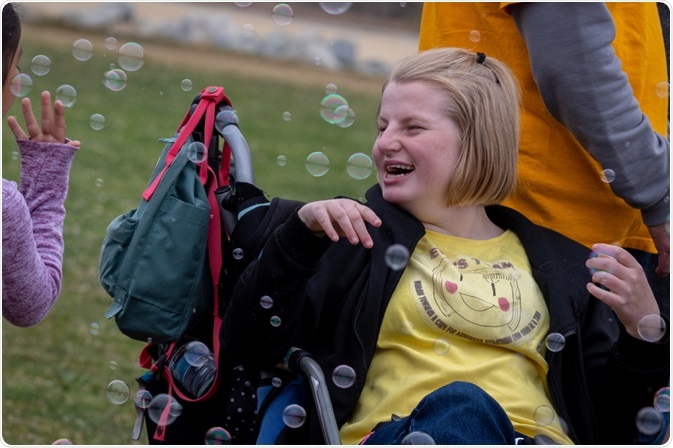Angelman syndrome is a genetic disorder resulting in severe intellectual disability.

Image Credit: Janson George / Shutterstock.com
This condition affects one in every 12,000 to 20,000 children and accounts for 6% of severely mentally disabled children who also have epilepsy.
Symptoms and signs
Children with Angelman syndrome often exhibit some form of developmental delay that becomes apparent by 6-12 months of age. After one year of age, this condition progresses to severe developmental delay.
Some of the different symptoms of Angelman syndrome can include ataxia with trembling limbs, impaired expressive speech, and a typically happy and hyperactive temperament with a short attention span, laughing, and sleep disturbances. As a result of these characteristics, Angelman syndrome in the past was commonly referred to as “happy puppet syndrome.”
It is notable that the characteristic features of Angelman syndrome are usually apparent only after the age of one year. Some of the less universal findings of Angelman syndrome include:
- Microcephaly
- Flat neck
- Pale skin and fair hair
- Widely spaced teeth
- Tongue protrusion
- Open mouth
- Scoliosis
- Constipation
- Feeding difficulties
The genetic basis of Angelman syndrome
Angelman syndrome is the result of a missing UBE3A gene on chromosome 15q. In over 70% of patients, Angelman syndrome arises due to maternal deletions of 15q11-13, which also produces the most severe form of the syndrome.
Other forms of the syndrome are due to uniparental disomy, imprinting center mutations, and UBE3A mutations. The UBE3A gene is part of a cluster of genes coding for GABA-receptor subunits. In about 20% of individuals with Angelman syndrome, no detectable mutation is present.
Diagnosis and treatment
Diagnosis of Angelman syndrome is based on the typical physical and developmental features, EEG changes, especially large-amplitude slow-spike waves, and genetic testing. More specifically, DNA methylation testing detects this condition in about 80% of patients.
Treatment of Angelman syndrome includes seizure control with anticonvulsants like sodium valproate, benzodiazepines, and ethosuximide. Other treatment components can include physiotherapy, speech therapy, and special education, each of which is required to improve the patient’s physical and mental skills, as well as prevent scoliosis and immobility.
Genetic counseling is necessary to assess the risk that siblings or other members of the extended family might have for Angelman syndrome. The risk of family members acquiring this condition is more than 50% when the causing factor is a mutation in the UBE3A gene; however, the risk is significantly lower when the condition is due to other mechanisms of chromosomal loss.

0Comments